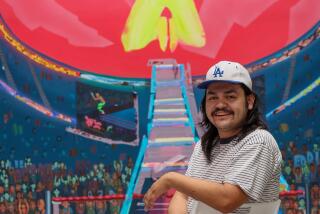ART EXHIBITS : Putting graffiti where it’s appreciated--the Contemporary Museum of Art II
Graffiti. Is it vandalism or is it art?
To spray-can artist Anthony Adomaitis of Torrance there is no question.
“The sad part is that the Brady Bunch-type family thinks it’s vandalism,” Adomaitis said. “If they take time out to (look at graffiti) they’d be amazed to see what graffiti is all about. They’d see some masterpieces.”
Adomaitis, 24, considers himself an old-timer when it comes to spray-can painting. He began practicing on walls in Carson and Long Beach a decade ago, before the hip hop-culture trademarks of rap, break-dancing and graffiti were used to market everything from sneakers to soft drinks. Adomaitis painted graffiti long before “tagging,” the practice of writing your name or gang affiliation to mark a territory, became common.
As a graffiti painter or “peacemaker,” Adomaitis didn’t just write his name, as taggers do. He created multicolored murals using stylized lettering and characters that often interpreted his urban world.
Twice he was caught by police for defacing public property but neither incident resulted in serious punishment. Today, Adomaitis practices in legal ways: drawing in sketchbooks, painting his designs on canvas, jackets, cars and the occasional wall of a local business. He’s begun drawing cartoons and has sold strips to a local magazine. He’s also been accepted to art school, but cannot afford tuition.
“Graffiti was like my mother when I was little,” he said. “It opened a lot of doors for me.”
About 20 works by Adomaitis and other Los Angeles peacemakers and graffiti crews will be on display starting Saturday at the South Bay Contemporary Museum of Art II, in a show called “Do It: Spray Can Art” The opening reception of the show, which runs through Aug. 28, begins at 8 p.m.
The exhibit will include work by Earth Crew, a group of young urban aerosol “writers,” break-dancers and rap musicians whose murals address such topics as gang violence, racism and drug abuse. The crew has created murals for Amnesty International, the Los Angeles Festival of the Arts and LA Gear.
The idea for the show was born when Adomaitis dropped by the South Bay Contemporary Museum to show his sketchbook to museum director Peggy Sivert.
“I looked at his portfolio and said, ‘We have to do this’ ” show, Sivert says. Sivert considers graffiti art honest and original. She calls it “the most important thing I’ve seen in 20 years as far as art movements go.”
The problem is that many graffiti painters have no legal place to paint and instead use public buildings, freeway walls and tunnels as a canvas.
“If they’re done on other people’s property it is vandalism and we don’t acknowledge that,” Sivert said. “But we do acknowledge that it is a phenomenon of our culture, that is speaking to us and we need to look at it, document it and understand it.”
The museum show is a “step in encouraging youth to use their talent in positive ways,” said Stephanie Sydney, member of the Graffiti Arts Coalition, a group recently founded to help artists find legal and safe places to work. The exhibit should help them realize that “they are part of the art world and not just outcasts and vandals,” she said.
A panel discussion on spray-can painting will be held Aug. 28 at 7 p.m. at the museum.
The South Bay Contemporary Museum of Art II is located at 1969 Obispo Ave. in Signal Hill. Museum hours are 11 a.m. to 5 p.m. Wednesday through Saturday. Information: (310) 985-0242.
More to Read
The biggest entertainment stories
Get our big stories about Hollywood, film, television, music, arts, culture and more right in your inbox as soon as they publish.
You may occasionally receive promotional content from the Los Angeles Times.










